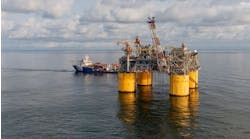OTC 2024: Chevron discusses keys to Anchor project success
Bruce Beaubouef * Managing Editor
HOUSTON – In 2019, Chevron’s Anchor project was the industry’s first high-pressure (>15,000 psi) deepwater development to achieve Final Investment Decision (FID).
On the first day of OTC 2024 in Houston, Tim Mitchell, Anchor Project Director, Chevron, provided an update on the project so far, and shared lessons learned and best practices that helped project teams successfully plan and execute this milestone project in the deepwater Gulf of Mexico.
Mitchell noted that to develop the high-pressure reservoir, Chevron had to undertake a “world class” technology development and qualification program to deliver various 20K drilling, completion, intervention, subsea and production technologies. The 20K technology development program required significant investment by the Anchor co-owners, Chevron and TotalEnergies, with participation by multiple industry contractors and suppliers.
One key decision, said Mitchell, was Chevron’s decision to enter into an $831-million contract with Transocean for the design, construction, and five-year operating terms for the Deepwater Titan drilling rig, a decision that was “made a full year before our final investment decision.” The award of this contract, he added, “was a huge step forward for Chevron to develop the Anchor asset,” and move the project forward. “In retrospect, it was a real leap of faith,” he said. Following that decision, Chevron began working with SLB OneSubsea to develop some of the key subsea components of the project.
Upon the completion of FEED activities, Chevron announced that it had reached FID on the $5.7-billion project in late 2019, with Phase 1 consisting of a seven-well subsea development plan and a semisubmersible floating production unit capable of handling pressures up to 20,000 psi.
And then just a few months later, the industry was hit with the COVID-19 pandemic, a downturn in commodity prices, industry consolidation and severe supply chain constraints. “Of course, the impacts of the pandemic were far reaching for us all,” Mitchell said. “All of us had to dig deep to keep moving forward, and it was a testament to everyone involved on the Anchor project to continue forward in the face of so much uncertainty.”
The project teams were faced with an “adaptive challenge” to enable the 20k technology under such circumstances – to qualify the equipment, obtain regulatory approvals, and move the technology forward from prototype to production within “a cost and schedule that would deliver our overall business objectives.” A key example of rising to meet the “adaptive challenge” was the development of a timeline and framework that ensured consistent delivery of “high-quality deliverables,” which in turn enabled the project to consistently move forward.
Mitchell said that there were five key operating principles that kept the project on schedule. The first was to develop and deliver a safe project enabling 20k technology. “Without 20k, we didn’t have a project,” Mitchell said. The second was “to embrace operational excellence in what we deliver, and to protect our people.” The third was to “preserve the environment, which is a core part of who we are and what we do, and gives us our license to operate.” The fourth was to “develop a passion to continuously innovate and to simplify” processes and procedures; and the fifth was “empower the team to collaborate to deliver a project that meets our financial and economic objectives.”
To date, the Anchor project team has drilled two wells, and is now in the process of completing one of these, Mitchell said. The semisubmersible floating platform, oil and gas pipelines, and much of the subsea architecture is in place.
Mitchell also noted that the project has had 13 million man-hours to date without injury to crew and workers. He added that the project is “on trend” to be commissioned within FID cost parameters and is on schedule to meet its online target date within this year.
05.05.2024




